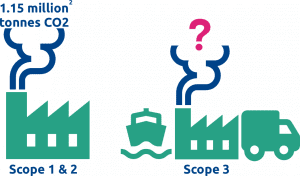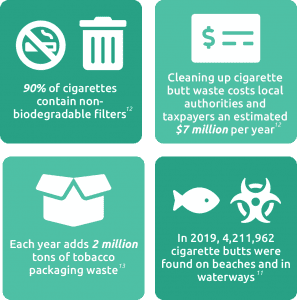Tobacco and the Environment
This page was last edited on at

Mural of Greta Thunberg on Tobacco Factory in Bristol, UK. “Bristol” by nicksarebi is licensed under CC BY 2.0
Key points
- The tobacco industry is a major contributor to both human and environmental damage.
- Tobacco products pollute the air with toxic smoke and the ground with waste, but the entire life cycle of products is damaging to the environment.
- The extent of environmental damage is not always clear, making it difficult to assess the true cost of tobacco.
- The tobacco industry uses tactics such as greenwashing and other forms of corporate social responsibility to distract from the impacts of their activities.
- The full environmental impact of newer products like e-cigarettes and heated tobacco products is unclear, although some estimate it could be even greater than that of conventional products.
A life-cycle of pollution and environmental damage
From cultivation to manufacturing, distribution, product use and post-consumer waste, tobacco-related activities are a threat to the environment.
It is an obligation, under Article 18 of the World Health Organization (WHO) Framework Convention on Tobacco Control (FCTC), for ratifying parties to ‘have due regard to the protection of the environment and the health of persons in relation to the environment in respect of tobacco cultivation and manufacture within their respective territories’.1
Given the large supply chains, and the numerous different parties and processes they involve, the exact environmental impact of the tobacco industry is difficult to measure.2 One estimate is that the entire lifecycle of a single cigarette produces 5.72 grams of CO2e.3 Equating this with the 6.25 trillion cigarettes produced worldwide leads to an estimated figure of 39.4 million tonnes of CO2e emitted yearly through the production of cigarettes alone.3. Other studies have estimated this figure to be as high as over 80 million tonnes of CO2 equivalent.4 This means that, as of 2020, the annual CO2 emissions of the tobacco industry are higher than those of entire countries, including Afghanistan (12.16 million tonnes), Croatia (16.98 million tonnes) and Denmark (26.19 million tonnes).5 As Dr Oleg Chestnov, Assistant Director-General of the WHO writes:
“The tobacco industry damages the environment in ways that go far beyond the effects of the smoke that cigarettes put into the air […] From start to finish, the tobacco life cycle is an overwhelmingly polluting and damaging process”6
Tobacco growing and curing
The first step in the lifecycle of tobacco products is the growing and curing of the tobacco plant itself. This process already has a large impact on the environment, in a number of ways, including deforestation,78 soil degradation,910 biodiversity loss,11 the use of pesticides1213 and adverse effects on farmers’ health.14
-
The resources and land needed to grow tobacco relies on the use of scarce land and the clearing of forests. Research found that the global production of six trillion cigarettes in 2014 used 4 million hectares of arable land. The majority of this tobacco was grown on scarce land in food-insecure countries, and then exported.4 Wood is also used in large quantities to cure the tobacco leaves. As a fast method of tobacco curing, ‘flue’ curing uses wood or coal burning to heat the air that cures the tobacco leaves. An estimated 50 million trees are cut down yearly for this purpose.2 Although more efficient methods of tobacco leaf curing exist, farmers may not be able to afford using these more sustainable methods. Instead, they maintain their practice of cutting down indigenous trees, which is harmful for the environment, but free for them.7 To get an idea of the scale of this problem, in the region of Mwazisi, Malawi, where tobacco is the main cash crop for farmers, forest cover has decreased from 66% in 1991 to 45.8% in 2017.8 Worldwide, an estimated 1.5 billion hectares of (mainly tropical) forests have been lost worldwide since the 1970s, contributing to up to 20% of annual greenhouse gas increases.6
-
Tobacco cultivation has been linked to soil degradation as well as deforestation.2 The planting of a monoculture crop and the use of herbicides and pesticides exhausts the soil and reduces its fertility, making it more difficult for plants to grow. Since tobacco absorbs more nitrogen, phosphorus and potassium than other major food and cash crops, tobacco growing decreases soil fertility more rapidly than other crops.9 Research published in 2021, on the decline in soil quality in Brazil, concluded that long-term tobacco cultivation in Brazil has led to increased soil erodibility and soil degradation.10
-
The 2017 WHO report on tobacco and the environment identified 13 countries across the globe where tobacco-driven habitat fragmentation and deforestation has been associated with a significant loss of biodiversity.6 As described above, tobacco farming leads to soil degradation, which hinders the maintenance of biodiversity.10 Moreover, farmers clear forested lands which are home to a wide variety of different animal and plant species, often by burning the forest down. This leads to the substantial and often irreversible losses of trees. The unsustainable farming practices used to cultivate tobacco have been linked to losses in biodiversity.2 Research conducted in Tanzania concluded that tobacco cultivation is the main driver of woodland degradation, significantly changing the natural environment.11
-
As tobacco is usually grown in monocultures, the crop is more vulnerable to pests and diseases. This means that farmers need to use large amounts of fertilisers, herbicides and pesticides in order to maintain a crop yield that can make a living wage.2 The use of chemical pesticides and fertilisers leads to water and soil contamination, as well as depletion of nutrients. A 2020 study found that, in Bangladesh, levels of water and soil contamination were higher for bodies of water next to tobacco cultivating land.12 The widespread use of pesticides also endangers the health of tobacco farmers. A risk assessment among Pakistani tobacco farmers conducted in 2010 found that during pesticide spraying, only 30% used shoes, 14% used masks and 9% used gloves. Of these farmers, the majority had mild to moderate pesticide poisoning.13 Between 1 and 5 million pesticide poisonings are recorded each year, resulting in an estimated 11,000 deaths among agricultural workers worldwide.2
-
Besides the health risks that farmers may experience when using pesticides, tobacco farmers are susceptible to what has become known as green tobacco sickness (GTS). GTS occurs when nicotine gets absorbed through the skin, mostly when someone is in contact with wet tobacco leaves.2 Symptoms include headaches, nausea, vomiting, weakness, dizziness and cramps. Seasonal prevalence of the illness ranged from 8% to as high as 89% of tobacco farmers.14 GTS is more likely to affect children, whose labour is used extensively in tobacco farming, not only because they have a relatively smaller body size, but also because they have not yet built up the nicotine tolerance which is needed protect them from these side effects.2
For more information on the harms caused specifically by tobacco cultivation, visit our tobacco farming page.

“Tobacco Plantation, Motueka, Nelson” by Archives New Zealand is licensed under CC BY 2.0
Manufacturing and distribution
After the growing and curing of tobacco, the next stage of the lifecycle of tobacco is the manufacturing and distribution of the products themselves. This process is also harmful to the environment, mostly through its carbon emissions. British American Tobacco (BAT) acknowledged in their 2019 sustainability report that: “our supply chain (scope 3) emissions represent 90% of our total carbon footprint”.15 Tobacco companies’ stated goals for reducing carbon emissions do not, however, reflect these acknowledged causes. In the same report, BAT stated its goal to be the reduction of scope 1 and 2 emissions by 30% by 202515. Scope 1 and 2 emissions refer to those under a company’s “direct control”. These exclude so-called scope 3 emissions, or those embedded in the purchase of goods and services, transportation and distribution, capital goods, and activities influenced but not controlled by companies. Scope 1 and 2 emissions are significant, with Philip Morris International (PMI) reporting average yearly emissions of 1.15 million tons of CO2 equivalent (CO2e).3 However, if (as BAT reports) scope 1 and 2 only make up 10% of total CO2 emissions, a 30% emission reductions may sound worthwhile, but it may not have the desired impact if it does not also include a reduction in what the company itself refers to as “90% of our total carbon footprint”, their scope 3 emissions.15
We do not have detailed data on the precise impact of the tobacco manufacturing and distribution process. Although tobacco companies freely admit that manufacturing is the most environmentally damaging part of the tobacco lifecycle, they seem reluctant to provide data that facilitates standardized calculation of the true environmental impact.6

Production process
The production of tobacco and its related products uses a considerable amount of resources such as water, wood and carbon fuels, often in a non-sustainable way. Beyond needing raw materials such as tobacco leaf and wood for the production of cigarettes, some industry techniques to increase efficiency also require increased energy consumption. In 2020, PMI reported their annual total energy consumed to be approximately 2,500 GWH.16 BAT reported the same annual total direct energy use in 2020.17 To put this into perspective, the WHO points out that this energy use is “equivalent to building around 2 million automobiles”.18
Consumption
With an estimated 5.7 trillion cigarettes smoked worldwide in 2016, smoking contributes to the release of toxic gases into our air.19 In cities such as Los Angeles and London, tobacco smoke has been demonstrated to have a measurable contribution to outdoor air pollution. As tobacco smoke residue remains on surfaces and in dust, it accumulates over time and has an effect on the environment and air quality long after the cigarettes have been extinguished.6
Post-consumer waste
Cigarette butts are the most littered item on the planet, with 4.5 trillion being discarded every year.18. They are the second most frequently littered item in beaches and waterways globally, generally comprising 30%-40% of items collected in annual coastal or urban clean-ups. They leach chemicals such as nicotine, ethylphenol and even heavy metals in water, contaminating the environment.20 People discarding their used cigarette butts on sidewalks, streets and in the environment may not consider how their non-biodegradable plastic filters may end up polluting rivers, oceans and beaches, if they aren’t eaten by wildlife before that.21 When consumed, cigarette butts may choke an animal or poison it and when contaminating water. Even one cigarette butt per litre of water can be lethal to fish.20 Research published by the Truth Initiative shows that the chemicals that leached from a single cigarette butt (soaked for 24 hours in a litre of water) released enough toxins to kill 50% of the saltwater and freshwater fish exposed to it for 96 hours.21
Thus, besides being unsightly, the waste resulting from cigarette butts is harmful to the environment and wildlife as well. Nevertheless, it remains a common issue, as the figures below show.

Note on data
Most of the data we have on the tobacco industry’s impact on the environment comes from the industry itself, and is therefore limited.6 While all of the largest transnational tobacco companies produce annual reports on their resource use and emissions, they may not report on all parts of the lifecycle. For example, JTI stopped reporting their revenue or cigarette production per unit of pollution after 2014, and Altria does not report any data on water discharge.3 More significant gaps in data exist, including the China National Tobacco Company, which produces 44% of the world’s cigarettes but does not provide any publicly available data on its environmental impact. There is a need for more reliable and standardized data on the environmental impact, so that we can understand the real cost of tobacco manufacturing.3
Greenwashing
Greenwashing is used by controversial industries to make themselves or their products seem more environmentally friendly, usually to increase sales or divert public attention away from their more environmentally damaging practices.22 As an example, British American Tobacco (BAT) in West and Central Africa has recently launched a “sustainability corner” at their factory where it exhibits products recycled from waste generated at this factory.23 This draws attention away from the problematic fact that BAT produces this waste in the first place from the creation of harmful tobacco products.
For more information on greenwashing, and examples of greenwashing practices by tobacco companies, see greenwashing.
Corporate Social Responsibility (CSR)
Corporate Social Responsibility is:
“The idea that a company should be interested in and willing to help society and the environment as well as be concerned about the products and profits it makes”24.
While CSR sounds like a positive practice, and is often seen to include activities such as donations to environmental organizations and collaborations with governments to address sustainability concerns, it is important to understand why tobacco companies would engage in such philanthropic behaviour. The tobacco industry uses CSR strategies to present themselves as a responsible corporation, and to distract from the overwhelming harm they cause to the environment.18
For more information, see Corporate Social Responsibility.
Newer nicotine and tobacco products
As the harms from conventional products have become better understood, and tobacco control measures have been put in place, the cigarette market – from which tobacco companies make most of their profits – has started to shrink. To secure the industry’s longer-term future, tobacco companies have invested in, developed and marketed various newer nicotine and tobacco products, including in low and middle-income countries.25 These products are being launched along with an industry-wide narrative of transformation towards harm reduction and sustainability, with tobacco companies seemingly linking these products to environmental sustainability.26 However, these newer products, including e-cigarettes (also known as electronic nicotine delivery systems, or ENDS) and heated tobacco products, may pose even greater environmental harms than conventional tobacco products, from their manufacturing to their disposal.
For example, a 2020 study noted that: “New classes of plastics, metals, cartridges, lithium-ion batteries, and concentrated nicotine solutions, used in many newer nicotine and tobacco electronic products, involves significantly more environmentally intensive manufacturing processes than products that are primarily made of plant material and plastic filters, as combustible cigarettes are.”3 Heated tobacco products, which use technological and battery-powered units to heat tobacco-containing sticks, combine the environmental impacts of the tobacco leaf supply chain with those of electronic components.
Waste from newer products is also a potentially more dangerous problem than waste from conventional products, like cigarette butts. E-cigarette waste can contaminate waterways and soil and endanger wildlife with plastic, nicotine salts, heavy metals, lead, mercury, and flammable lithium-ion batteries. 27 The rising popularity of pod-based e-cigarette devices, such as those sold by JUUL Labs, has meant an increase in the improper disposal of these plastic components, which cannot decompose even under severe conditions, and break down into microplastics and chemicals that pollute waterways.2829
Despite growing concerns, the exact environmental impact of these newer products remains unclear, as there is little independent data assessing the lifecycle impact of these products.30
Tobacco Tactics Resources
Relevant Links
- BAT sustainability webpage
- PMI sustainability webpage
- JTI sustainability webpage
- Altria Group sustainability webpage
- Imperial Brands sustainability webpage
TCRG Research
- Hoek, P. Gendall, M. Blank, L. Robertson & L. Marsh, Butting out: an analysis of support for measures to address tobacco product waste, Tobacco Control, 2020;29:131-137, doi: 10.1136/tobaccocontrol-2019-054956
For a comprehensive list of all TCRG publications, including TCRG research that evaluates the impact of public health policy, go to the Bath TCRG’s list of publications.